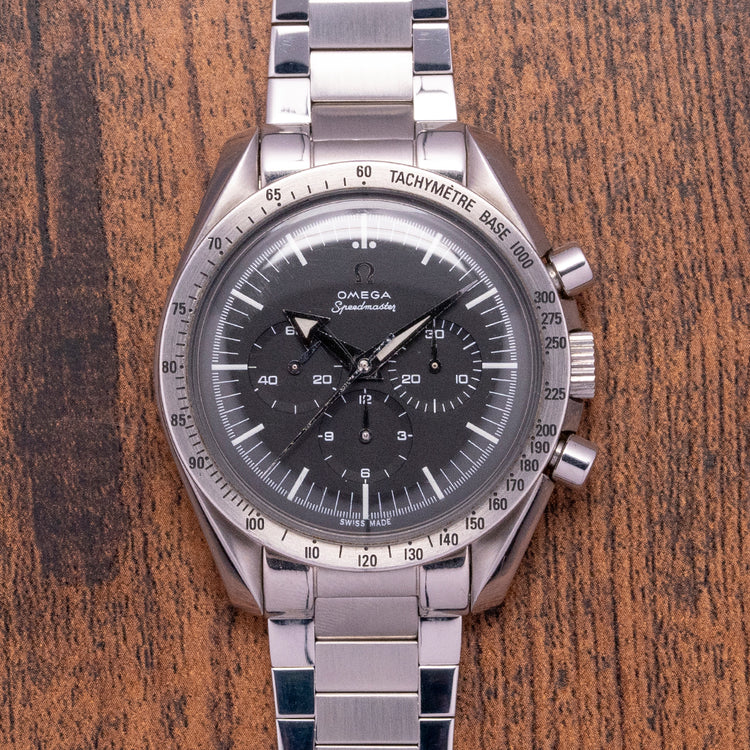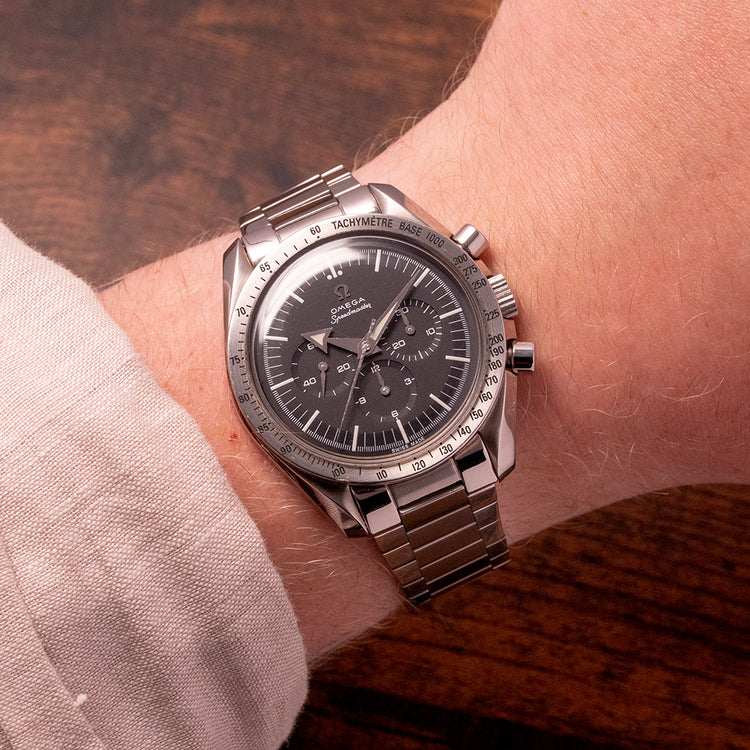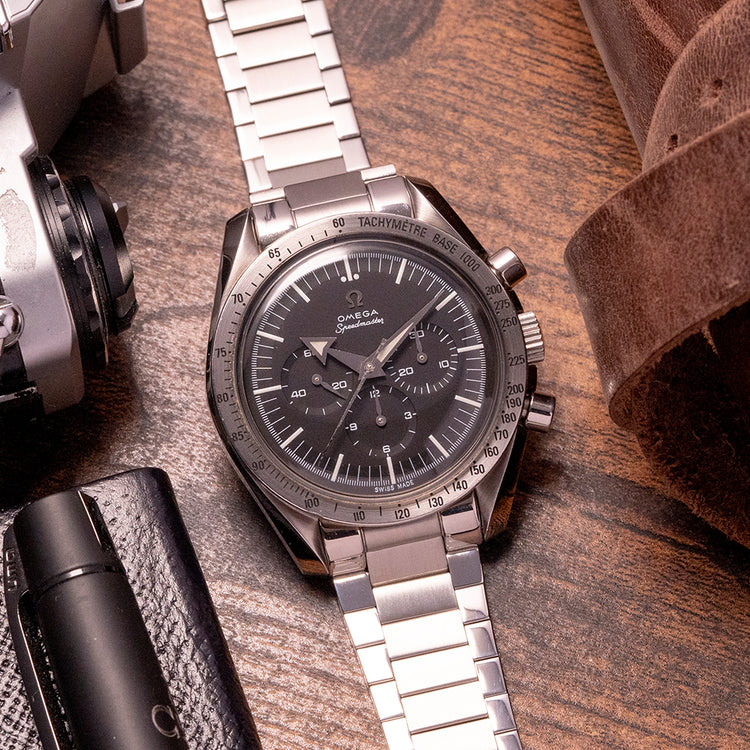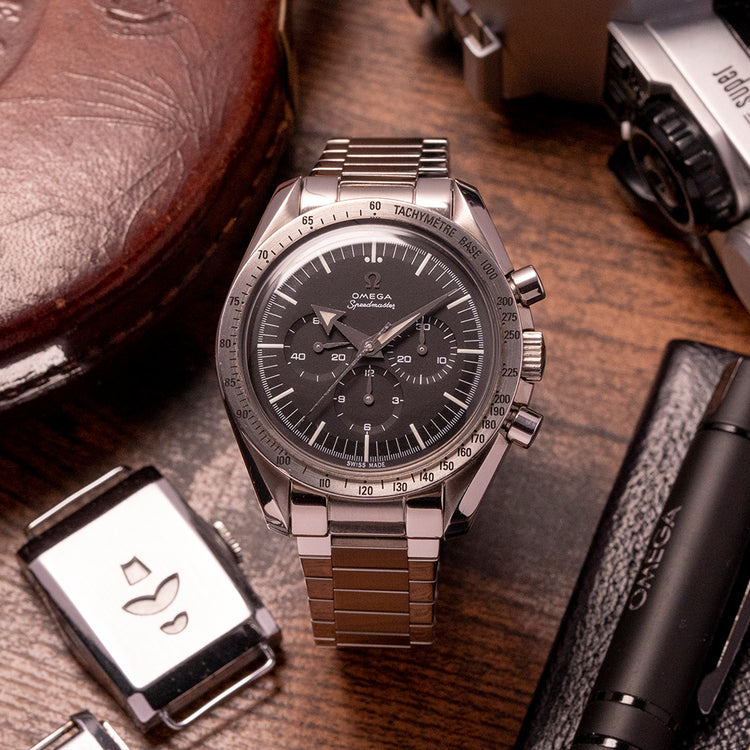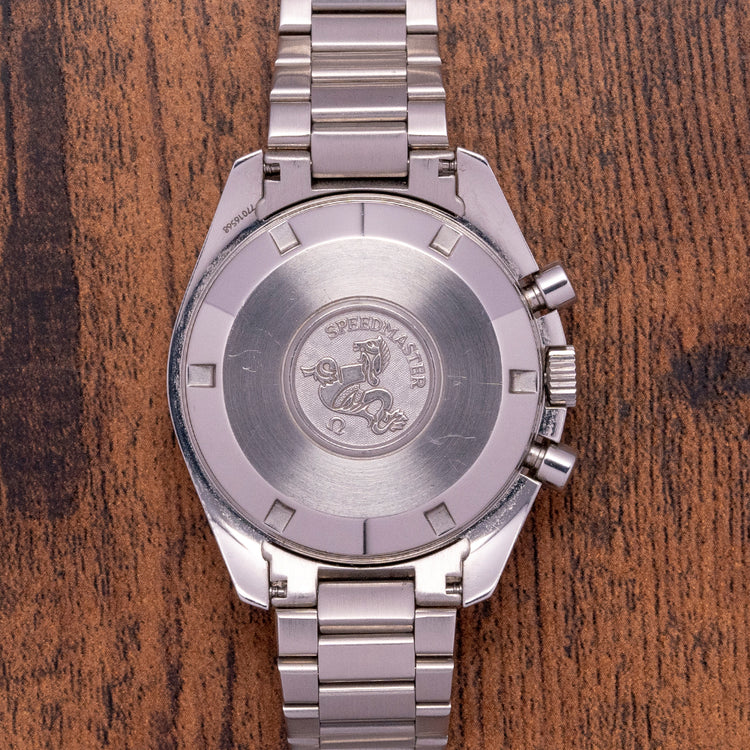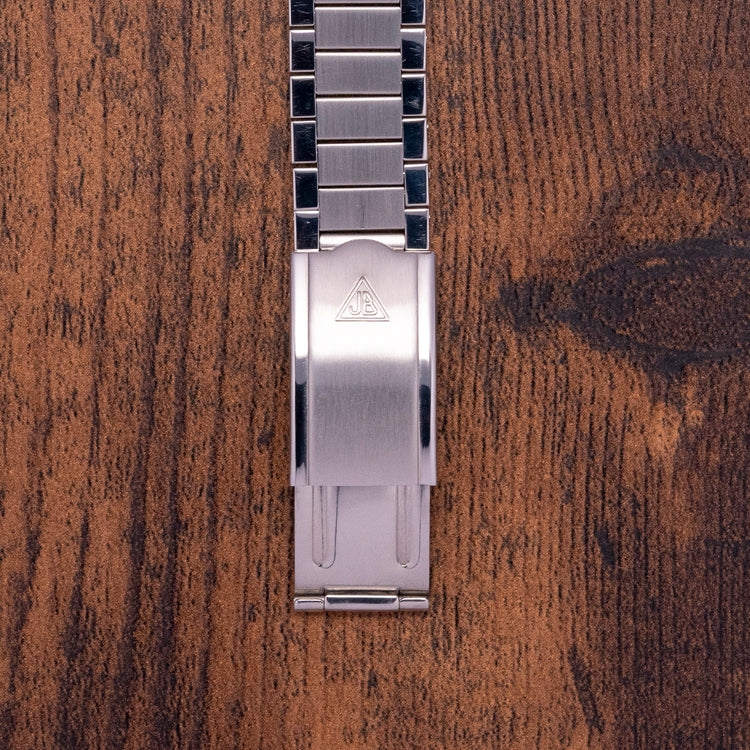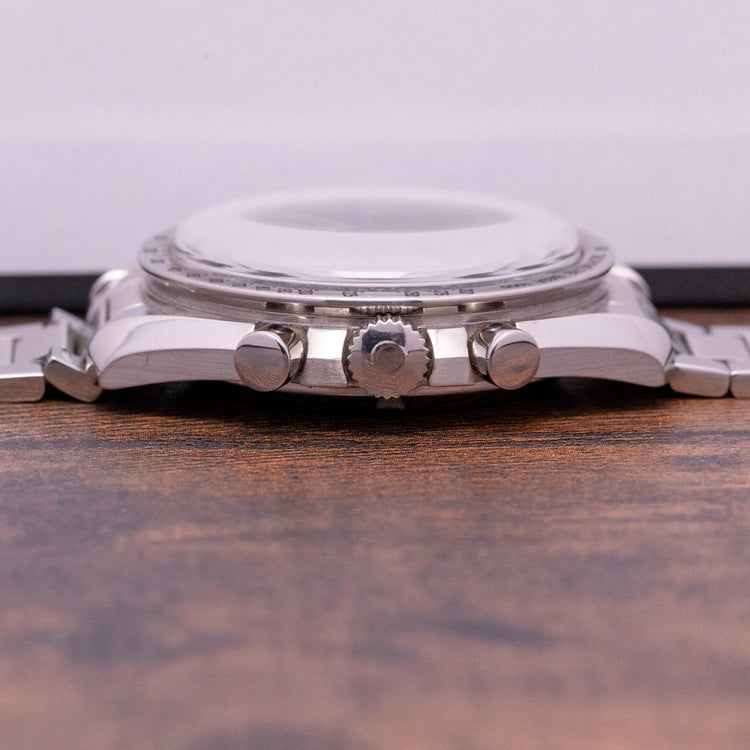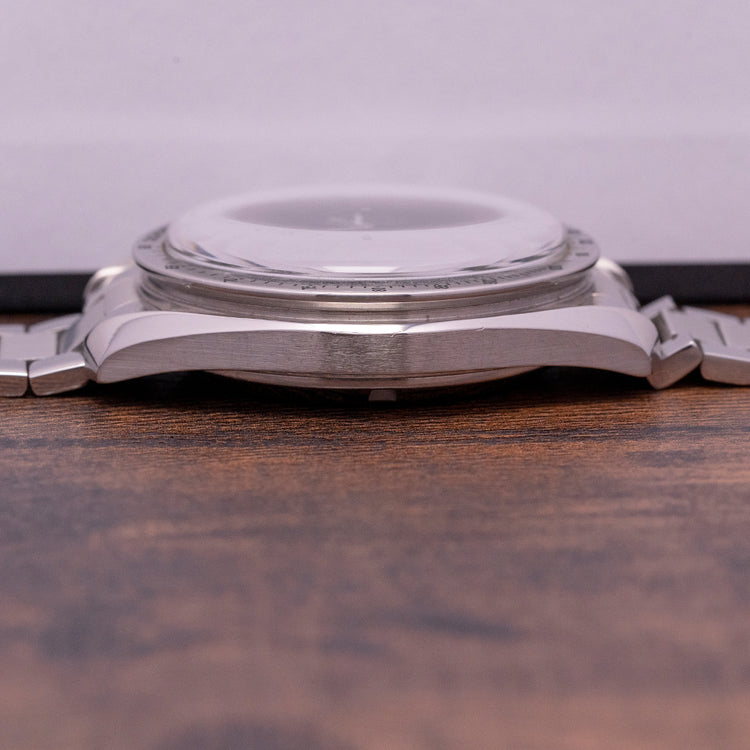More Information
Description
More
Less
The Watch
Here we have a 1990s Omega Speedmaster Broad Arrow Manual 3594.50.00, based on the original 1957 “Broad Arrow”, which was not only the first Speedmaster, it was also the first chronograph wristwatch in the world with its tachymeter scale on the bezel. Released in 1997 it celebrated the 40th Anniversary of the release of the CK2915, the 42mm asymmetric case has brushed and polished surfaces, twisted tapered lugs that provide a comfortable fit on your wrist, and a lug-to-lug length of 47.5mm and a thickness of 14mm gives the watch an impressive wrist presence. On the right side, we have the piston pushers and a signed crown in the centre, a thin brushed stainless steel bezel has the Tachymeter scale engraved and painted black. A domed Hesalite crystal sits above a matte black dial, and an outer minute and seconds track is precisely executed with white baton indexes marking the hours. The three registers are slightly recessed, at 3 o’clock 30 minutes, at 6 o’clock 12 hours and finally at 9 o’clock small seconds. Steel Broad Arrow hands are infilled with lume and complemented by a tapered chronograph hand. At 12 o’clock we have the Omega Speedmaster motif completing this accurate re-edition of a true icon. On the reverse a screw-down case back with the embossed Speedmaster Hippocampus in the centre, inside we have the Cal. 1861, 18 jewels hand-wound chronograph beating at 21,600 bph. It has a Rhodium-plated finish, as a manual wound movement, it is the direct descendant of the original moon watch that used the Cal. 361 movement. The watch comes paired with a 20mm Forstner flat-link polished and brushed bracelet with a signed folding clasp and the watch comes with its Omega presentation box.
Points of Mention
This watch is sold with its original Omega box but no Omega paperwork. The watch comes paired with a 20mm Forstner flat-link polished and brushed bracelet with a signed folding clasp. The watch is from Circa. Late 1990s and is in worn condition, however, as you can see from the photos it is in great overall condition with few signs of wear. The watch comes with our 12-Months NON-Waterproof Warranty.
For more photos see here - https://drive.google.com/drive/folders/1wQCFe_Mvm21BJIbLGJZ5peWstKTWVp6Y?usp=sharing
4K YouTube video, skip to 13:03 - https://youtu.be/qzK1Tq-AFs4
Personal Note
Before this model landed on my desk I had no idea it existed, that is the beauty of watches, still after so many years I am surprised by something new... This reference provides all the vintage charm and beauty of the Broad Arrow, but packaged in the classic 42mm Speedmaster Professional case, I'm a fan! Plus, this model from the late 1990s is an absolute steal value-wise compared to almost all Broad Arrow releases, so I wouldn't hesitate on this one if you are after the design but not the higher price tag!
Specification
Lugs : 20mm
Condition : Pre-Owned
Box & Papers : Box
Case Material : Stainless Steel
Warranty : 12-Months NON-Waterproof Warranty
The Brand
Formerly known as the La Generale Watch Co. in 1848 founded by Louis Brandt in La Chaux-de-Fonds. When he died in 1879, his sons carried on his dream. In 1880 they moved to 96 Rue Jakob-Stampfli where they remain today. The brothers produced their first mass-produced calibre, the Labrador In 1885. Just a few years later in 1892, they produced the first minute-repeater. In 1903 they renamed the company Omega until 1982 when they officially changed their name to Omega SA. During WW1 Omega watches were used as official timekeepers for the Royal Flying Corps and the US Army. In 1930, Omega and Tissot merged together to form Société Suisse pour l'Industrie Horlogère (SSIH) In 1931, another group was formed - Allgemeine Schweizerische Uhrenindustrie AG (ASUAG). Where SSIH was primarily French-speaking, ASUAG was founded by the more German-speaking members of the Swiss watch industry. In 1948 they introduced the first edition of one of its most symbolic watches: the Seamaster. Omega first introduced the Constellation in 1952. At the time it was Omega's flagship timepiece. The first models had a Cal. 354 bumper movement in them. Later in 1955, Omega introduced the Automatic Cal. 50x, followed in 1959 by the Cal.55x (no date) and 56x (date) versions. Many of the Constellations came with pie-pan dials, diamond indexes, and fancy lug configurations. All the gold Constellations of that time have the Observatory of Geneva's hand engraved on the back. The stainless steel and stainless steel/gold versions had a gold medallion on the back with the Observatory of Geneva. The eight stars above the Observatory stand for the many exploits of Omega in the world Chronometer competition. Celebrating the fact that all Constellations are Chronometer Certified. In 1962, when astronaut Wally Schirra wore a Speedmaster on his Mercury Sigma 7 Mission, making it the first Omega watch to enter space. After rigorous tests, NASA used Omega for all their Apollo missions including the 1969 Moon landing of Apollo 11. Today Omega is still an astronaut's first choice. In 1969, President Nixon famously said it was “too valuable” and turned down the first-ever all-gold Speedmaster Professional Deluxe. As a response to the ever-growing threat of electronic watches to the manufacturers of mechanical watches, Omega and many Swiss brands such as Rolex and Patek Philippe formed Centre Electronique Horologer (CEH). Prototypes began to appear in 1967 with their production starting in 1968. Then In 1972, Omega introduced the reference, 198.030, which included the Omega calibre 1250, a ‘tuning-fork electronic movement made under Bulova's licence. Later we saw a merger of SSIH and ASUAG into SMH, or Société de Microélectronique et d’Horlogerie. This merger took place in 1983. In 1992, the company acquired Blancpain, and in 1998 it officially rebranded itself from SMH to the Swatch Group. Then, in 1999, they purchased and integrated Breguet into the Swatch Group.
Points of Mention
More
Less
Personal Note
More
Less
Specification
More
Less
Movement : Manually Wound Omega Cal. 1861
Age : Circa. 1990s
Year : Circa. 1990s
Case Size : 42mm
Case Thickness : 14 mm
Lug to Lug : 47.5mm
Lugs : 20mm
Condition : Pre-Owned
Box and Papers : Box
Case Material : Stainless Steel
Warranty : 12-Months NON-Waterproof Warranty
The wrist model's wrist size is 7inch
About Omega
More
Less
Description
The Watch
Here we have a 1990s Omega Speedmaster Broad Arrow Manual 3594.50.00, based on the original 1957 “Broad Arrow”, which was not only the first Speedmaster, it was also the first chronograph wristwatch in the world with its tachymeter scale on the bezel. Released in 1997 it celebrated the 40th Anniversary of the release of the CK2915, the 42mm asymmetric case has brushed and polished surfaces, twisted tapered lugs that provide a comfortable fit on your wrist, and a lug-to-lug length of 47.5mm and a thickness of 14mm gives the watch an impressive wrist presence. On the right side, we have the piston pushers and a signed crown in the centre, a thin brushed stainless steel bezel has the Tachymeter scale engraved and painted black. A domed Hesalite crystal sits above a matte black dial, and an outer minute and seconds track is precisely executed with white baton indexes marking the hours. The three registers are slightly recessed, at 3 o’clock 30 minutes, at 6 o’clock 12 hours and finally at 9 o’clock small seconds. Steel Broad Arrow hands are infilled with lume and complemented by a tapered chronograph hand. At 12 o’clock we have the Omega Speedmaster motif completing this accurate re-edition of a true icon. On the reverse a screw-down case back with the embossed Speedmaster Hippocampus in the centre, inside we have the Cal. 1861, 18 jewels hand-wound chronograph beating at 21,600 bph. It has a Rhodium-plated finish, as a manual wound movement, it is the direct descendant of the original moon watch that used the Cal. 361 movement. The watch comes paired with a 20mm Forstner flat-link polished and brushed bracelet with a signed folding clasp and the watch comes with its Omega presentation box.
Points of Mention
This watch is sold with its original Omega box but no Omega paperwork. The watch comes paired with a 20mm Forstner flat-link polished and brushed bracelet with a signed folding clasp. The watch is from Circa. Late 1990s and is in worn condition, however, as you can see from the photos it is in great overall condition with few signs of wear. The watch comes with our 12-Months NON-Waterproof Warranty.
For more photos see here - https://drive.google.com/drive/folders/1wQCFe_Mvm21BJIbLGJZ5peWstKTWVp6Y?usp=sharing
4K YouTube video, skip to 13:03 - https://youtu.be/qzK1Tq-AFs4
Personal Note
Before this model landed on my desk I had no idea it existed, that is the beauty of watches, still after so many years I am surprised by something new... This reference provides all the vintage charm and beauty of the Broad Arrow, but packaged in the classic 42mm Speedmaster Professional case, I'm a fan! Plus, this model from the late 1990s is an absolute steal value-wise compared to almost all Broad Arrow releases, so I wouldn't hesitate on this one if you are after the design but not the higher price tag!
Specification
Lugs : 20mm
Condition : Pre-Owned
Box & Papers : Box
Case Material : Stainless Steel
Warranty : 12-Months NON-Waterproof Warranty
The Brand
Formerly known as the La Generale Watch Co. in 1848 founded by Louis Brandt in La Chaux-de-Fonds. When he died in 1879, his sons carried on his dream. In 1880 they moved to 96 Rue Jakob-Stampfli where they remain today. The brothers produced their first mass-produced calibre, the Labrador In 1885. Just a few years later in 1892, they produced the first minute-repeater. In 1903 they renamed the company Omega until 1982 when they officially changed their name to Omega SA. During WW1 Omega watches were used as official timekeepers for the Royal Flying Corps and the US Army. In 1930, Omega and Tissot merged together to form Société Suisse pour l'Industrie Horlogère (SSIH) In 1931, another group was formed - Allgemeine Schweizerische Uhrenindustrie AG (ASUAG). Where SSIH was primarily French-speaking, ASUAG was founded by the more German-speaking members of the Swiss watch industry. In 1948 they introduced the first edition of one of its most symbolic watches: the Seamaster. Omega first introduced the Constellation in 1952. At the time it was Omega's flagship timepiece. The first models had a Cal. 354 bumper movement in them. Later in 1955, Omega introduced the Automatic Cal. 50x, followed in 1959 by the Cal.55x (no date) and 56x (date) versions. Many of the Constellations came with pie-pan dials, diamond indexes, and fancy lug configurations. All the gold Constellations of that time have the Observatory of Geneva's hand engraved on the back. The stainless steel and stainless steel/gold versions had a gold medallion on the back with the Observatory of Geneva. The eight stars above the Observatory stand for the many exploits of Omega in the world Chronometer competition. Celebrating the fact that all Constellations are Chronometer Certified. In 1962, when astronaut Wally Schirra wore a Speedmaster on his Mercury Sigma 7 Mission, making it the first Omega watch to enter space. After rigorous tests, NASA used Omega for all their Apollo missions including the 1969 Moon landing of Apollo 11. Today Omega is still an astronaut's first choice. In 1969, President Nixon famously said it was “too valuable” and turned down the first-ever all-gold Speedmaster Professional Deluxe. As a response to the ever-growing threat of electronic watches to the manufacturers of mechanical watches, Omega and many Swiss brands such as Rolex and Patek Philippe formed Centre Electronique Horologer (CEH). Prototypes began to appear in 1967 with their production starting in 1968. Then In 1972, Omega introduced the reference, 198.030, which included the Omega calibre 1250, a ‘tuning-fork electronic movement made under Bulova's licence. Later we saw a merger of SSIH and ASUAG into SMH, or Société de Microélectronique et d’Horlogerie. This merger took place in 1983. In 1992, the company acquired Blancpain, and in 1998 it officially rebranded itself from SMH to the Swatch Group. Then, in 1999, they purchased and integrated Breguet into the Swatch Group.
Points of Mention
Personal Note
Specification
The Brand
Enquire or Book an Appointment
Would you like to discover further details about this watch, or perhaps arrange an appointment to view and try it on? Complete this form and a member of our team will get back to you shortly.
You May Also Like




















